Supramolecular Adhesives Inspired by Nature: Concept and Applications
Abstract
1. Introduction
2. Mechanistic Feature of Design
2.1. H-Bonding
2.2. Host–Guest Interaction
2.3. Metal Coordination
2.4. Electrostatic Interactions
2.5. π–π Stacking
2.6. Hydrophobic Effects
3. Applications
3.1. Robust Supramolecular Adhesives
3.2. Stimuli-Responsive Adhesives
3.3. Biologically Relevant Adhesives
4. Advantages, Current Challenges, and Prospects
5. Conclusions
Author Contributions
Funding
Conflicts of Interest
Abbreviations
| Az | Azobenzene |
| bpy | 2,2’-bipyridyl |
| CB | Cucurbit[n]uril |
| CD | Cyclodextrin |
| DES | Deep eutectic solvents |
| DMA | Dopamine methacrylamide |
| DOPA | Dihydroxyphenylalanine |
| GO | Graphene oxide |
| PAA | Polyacrylic acid |
| PDAP | Poly(diaminopyridine acrylamide |
| PEGSD | Poly(glycerolsebacate)-co-poly(ethylene glycol)-g-catechol |
| PEI | Polyethyleneimine |
| PHEMA | Poly(2-hydroxyethyl methacrylate) |
| PMBT | Poly(1-[2-methacryloylethyl]-3-methylimidazolium bis(trifluoromethane)-sulfonamide) |
| PMMA | Poly(methyl methacrylate) |
| PTFE | Polytetrafluoroethylene |
| pThy | Poly(thymine) |
| SDS | Sodium dodecyl sulfate |
| tBu | tert-butyl |
| TMCS | Tetramethylcyclotetrasiloxane |
| UPy | Ureidopyrimidinone |
References
- Flammang, P.; Santos, R. Biological adhesives: From biology to biomimetics. Interface Focus 2015, 5, 20140086. [Google Scholar] [CrossRef][Green Version]
- Wang, C.S.; Stewart, R.J. Multipart copolyelectrolyte adhesive of the sandcastle worm, Phragmatopoma californica (Fewkes): Catechol oxidase catalyzed curing through peptidyl-DOPA. Biomacromolecules 2013, 14, 1607–1617. [Google Scholar] [CrossRef]
- Waite, J.H. Mussel adhesion–essential footwork. J. Exp. Biol. 2017, 220, 517–530. [Google Scholar] [CrossRef]
- Giuri, D.; Ravarino, P.; Tomasini, C. L-Dopa in small peptides: An amazing functionality to form supramolecular materials. Org. Biomol. Chem. 2021, 19, 4622–4636. [Google Scholar] [CrossRef]
- Moulay, S. Dopa/catechol-tethered polymers: Bioadhesives and biomimetic adhesive materials. Polym. Rev. 2014, 54, 436–513. [Google Scholar] [CrossRef]
- Sun, J.; Xiao, L.; Li, B.; Zhao, K.; Wang, Z.; Zhou, Y.; Ma, C.; Li, J.; Zhang, H.; Herrmann, A.; et al. Genetically engineered polypeptide adhesive coacervates for surgical applications. Angew. Chem. Int. Ed. 2021, 60, 23687–23694. [Google Scholar] [CrossRef]
- Ahn, Y.; Jang, Y.; Selvapalam, N.; Yun, G.; Kim, K. Supramolecular velcro for reversible underwater adhesion. Angew. Chem. Int. Ed. 2013, 52, 3140–3144. [Google Scholar] [CrossRef] [PubMed]
- Wang, W.; An, Z.; Wang, Z.; Wang, S. Chemical Design of Supramolecular Reversible Adhesives for Promising Applications. Chem.-Eur. J. 2024, 30, e202304349. [Google Scholar] [CrossRef]
- Liu, J.; Tan, C.S.Y.; Scherman, O.A. Dynamic interfacial adhesion through cucurbit [n] uril molecular recognition. Angew. Chem. Int. Ed. 2018, 57, 8854–8858. [Google Scholar] [CrossRef] [PubMed]
- Tan, P.; Wang, H.; Xiao, F.; Lu, X.; Shang, W.; Deng, X.; Song, H.; Xu, Z.; Cao, J.; Gan, T.; et al. Solution-processable, soft, self-adhesive, and conductive polymer composites for soft electronics. Nat. Commun. 2022, 13, 358. [Google Scholar] [CrossRef]
- Xiao, Z.; Li, Q.; Liu, H.; Zhao, Q.; Niu, Y.; Zhao, D. Adhesion mechanism and application progress of hydrogels. Eur. Polym. J. 2022, 173, 111277. [Google Scholar] [CrossRef]
- Yao, H.; Wu, M.; Lin, L.; Wu, Z.; Bae, M.; Park, S.; Wang, S.; Zhang, W.; Gao, J.; Wang, D.; et al. Design strategies for adhesive hydrogels with natural antibacterial agents as wound dressings: Status and trends. Mater. Today Bio 2022, 16, 100429. [Google Scholar] [CrossRef]
- Zhao, Y.; Song, S.; Ren, X.; Zhang, J.; Lin, Q.; Zhao, Y. Supramolecular adhesive hydrogels for tissue engineering applications. Chem. Rev. 2022, 122, 5604–5640. [Google Scholar] [CrossRef] [PubMed]
- Zhang, W.; Wang, R.; Sun, Z.; Zhu, X.; Zhao, Q.; Zhang, T.; Cholewinski, A.; Yang, F.K.; Zhao, B.; Pinnaratip, R.; et al. Catechol-functionalized hydrogels: Biomimetic design, adhesion mechanism, and biomedical applications. Chem. Soc. Rev. 2020, 49, 433–464. [Google Scholar] [CrossRef]
- Han, L.; Lu, X.; Liu, K.; Wang, K.; Fang, L.; Weng, L.T.; Zhang, H.; Tang, Y.; Ren, F.; Zhao, C.; et al. Mussel-inspired adhesive and tough hydrogel based on nanoclay confined dopamine polymerization. ACS Nano 2017, 11, 2561–2574. [Google Scholar] [CrossRef]
- Su, X.; Wang, H.; Tian, Z.; Duan, X.; Chai, Z.; Feng, Y.; Wang, Y.; Fan, Y.; Huang, J. A solvent co-cross-linked organogel with fast self-healing capability and reversible adhesiveness at extreme temperatures. ACS Appl. Mater. Interfaces 2020, 12, 29757–29766. [Google Scholar] [CrossRef]
- Sun, T.L.; Kurokawa, T.; Kuroda, S.; Ihsan, A.B.; Akasaki, T.; Sato, K.; Haque, M.A.; Nakajima, T.; Gong, J.P. Physical hydrogels composed of polyampholytes demonstrate high toughness and viscoelasticity. Nat. Mater. 2013, 12, 932–937. [Google Scholar] [CrossRef]
- Burattini, S.; Greenland, B.W.; Merino, D.H.; Weng, W.; Seppala, J.; Colquhoun, H.M.; Hayes, W.; Mackay, M.E.; Hamley, I.W.; Rowan, S.J. A healable supramolecular polymer blend based on aromatic π-π stacking and hydrogen-bonding interactions. J. Am. Chem. Soc. 2010, 132, 12051–12058. [Google Scholar] [CrossRef]
- Hou, Y.; Song, Y.; Sun, X.; Jiang, Y.; He, M.; Li, Y.; Chen, X.; Zhang, L. Multifunctional composite hydrogel bolus with combined self-healing, antibacterial and adhesive functions for radiotherapy. J. Mater. Chem. B 2020, 8, 2627–2635. [Google Scholar] [CrossRef]
- Wang, Y.; Garcia, C.R.; Ding, Z.; Gabrilska, R.; Rumbaugh, K.P.; Wu, J.; Liu, Q.; Li, W. Adhesive, self-healing, and antibacterial chitosan hydrogels with tunable two-layer structures. ACS Sustain. Chem. Eng. 2020, 8, 18006–18014. [Google Scholar] [CrossRef]
- Lahiri, H.; Basu, K. Supramolecular Sensing Platforms: Techniques for In Vitro Biosensing. ChemEngineering 2024, 8, 66. [Google Scholar] [CrossRef]
- Jeffrey, G.A.; Saenger, W. Hydrogen Bonding in Biological Structures; Springer Science & Business Media: Berlin/Heidelberg, Germany, 1991. [Google Scholar]
- Cheng, S.; Zhang, M.; Dixit, N.; Moore, R.B.; Long, T.E. Nucleobase self-assembly in supramolecular adhesives. Macromolecules 2012, 45, 805–812. [Google Scholar] [CrossRef]
- Liu, X.; Zhang, Q.; Gao, G. Bioinspired adhesive hydrogels tackified by nucleobases. Adv. Funct. Mater. 2017, 27, 1703132. [Google Scholar] [CrossRef]
- Feula, A.; Tang, X.; Giannakopoulos, I.; Chippindale, A.M.; Hamley, I.W.; Greco, F.; Buckley, C.P.; Siviour, C.R.; Hayes, W. An adhesive elastomeric supramolecular polyurethane healable at body temperature. Chem. Sci. 2016, 7, 4291–4300. [Google Scholar] [CrossRef]
- Zhang, L.; Wang, D.; Xu, L.; Zhang, A. A supramolecular polymer with ultra-stretchable, notch-insensitive, rapid self-healing and adhesive properties. Polym. Chem. 2021, 12, 660–669. [Google Scholar] [CrossRef]
- Wu, S.; Cai, C.; Li, F.; Tan, Z.; Dong, S. Supramolecular adhesive materials from natural acids and sugars with tough and organic solvent-resistant adhesion. CCS Chem. 2021, 3, 1690–1700. [Google Scholar] [CrossRef]
- Zhu, H.; Demirci, A.; Liu, Y.; Gong, J.; Mitsuishi, M. Robust, reusable, and antioxidative supramolecular adhesive to inorganic surfaces based on water-stimulated hydrogen bonding. ACS Appl. Polym. Mater. 2022, 4, 1586–1594. [Google Scholar] [CrossRef]
- Nakamura, T.; Takashima, Y.; Hashidzume, A.; Yamaguchi, H.; Harada, A. A metal–ion-responsive adhesive material via switching of molecular recognition properties. Nat. Commun. 2014, 5, 4622. [Google Scholar] [CrossRef]
- Roling, O.; Stricker, L.; Voskuhl, J.; Lamping, S.; Ravoo, B.J. Supramolecular surface adhesion mediated by azobenzene polymer brushes. Chem. Commun. 2016, 52, 1964–1966. [Google Scholar] [CrossRef] [PubMed]
- Zhang, Q.; Li, T.; Duan, A.; Dong, S.; Zhao, W.; Stang, P.J. Formation of a supramolecular polymeric adhesive via water–participant hydrogen bond formation. J. Am. Chem. Soc. 2019, 141, 8058–8063. [Google Scholar] [CrossRef]
- Chan, M.H.Y.; Yam, V.W.W. Toward the design and construction of supramolecular functional molecular materials based on metal–metal interactions. J. Am. Chem. Soc. 2022, 144, 22805–22825. [Google Scholar] [CrossRef]
- Sun, P.; Mei, S.; Xu, J.F.; Zhang, X. A Bio-Based Supramolecular Adhesive: Ultra-High Adhesion Strengths at both Ambient and Cryogenic Temperatures and Excellent Multi-Reusability. Adv. Sci. 2022, 9, 2203182. [Google Scholar] [CrossRef]
- Deng, Q.; Han, S.; Wu, Y.; Chen, Y.; Zhang, Y.; Zhao, Y.; Chen, S.; Zhu, J. Robust and Reversible Thermal/Electro-Responsive Supramolecular Polymeric Adhesives via Synergistic Hydrogen-Bonds and Ionic Junctions. Angew. Chem. Int. Ed. 2025, 64, e202415386. [Google Scholar] [CrossRef] [PubMed]
- Zhang, J.; Wang, W.; Zhang, Y.; Wei, Q.; Han, F.; Dong, S.; Liu, D.; Zhang, S. Small-molecule ionic liquid-based adhesive with strong room-temperature adhesion promoted by electrostatic interaction. Nat. Commun. 2022, 13, 5214. [Google Scholar] [CrossRef] [PubMed]
- Liu, Y.; Zhao, R.; Li, S.; Xue, X.; Zhang, Q.; Shi, F.; Cheng, M. Robust electrostatically interactive hydrogel coatings for macroscopic supramolecular assembly via rapid wet adhesion. ACS Appl. Mater. Interfaces 2023, 15, 21640–21650. [Google Scholar] [CrossRef] [PubMed]
- Fan, L.; Xie, J.; Zheng, Y.; Wei, D.; Yao, D.; Zhang, J.; Zhang, T. Antibacterial, self-adhesive, recyclable, and tough conductive composite hydrogels for ultrasensitive strain sensing. ACS Appl. Mater. Interfaces 2020, 12, 22225–22236. [Google Scholar] [CrossRef]
- Yang, B.; Song, J.; Jiang, Y.; Li, M.; Wei, J.; Qin, J.; Peng, W.; López Lasaosa, F.; He, Y.; Mao, H.; et al. Injectable adhesive self-healing multicross-linked double-network hydrogel facilitates full-thickness skin wound healing. ACS Appl. Mater. Interfaces 2020, 12, 57782–57797. [Google Scholar] [CrossRef]
- Yan, J.; Ji, Y.; Huang, M.; Li, T.; Liu, Y.; Lu, S.; Liu, M. Nucleobase-inspired self-adhesive and inherently antibacterial hydrogel for wound dressing. ACS Mater. Lett. 2020, 2, 1375–1380. [Google Scholar] [CrossRef]
- Han, L.; Wang, M.; Prieto-López, L.O.; Deng, X.; Cui, J. Self-hydrophobization in a dynamic hydrogel for creating nonspecific repeatable underwater adhesion. Adv. Funct. Mater. 2020, 30, 1907064. [Google Scholar] [CrossRef]
- Li, X.; Deng, Y.; Lai, J.; Zhao, G.; Dong, S. Tough, long-term, water-resistant, and underwater adhesion of low-molecular-weight supramolecular adhesives. J. Am. Chem. Soc. 2020, 142, 5371–5379. [Google Scholar] [CrossRef] [PubMed]
- Liang, Y.; Wang, K.; Li, J.; Zhang, Y.; Liu, J.; Zhang, K.; Cui, Y.; Wang, M.; Liu, C.S. Low-molecular-weight supramolecular adhesives based on non-covalent self-assembly of a small molecular gelator. Mater. Horizons 2022, 9, 1700–1707. [Google Scholar] [CrossRef]
- Deng, Y.; Zhang, Q.; Shi, C.; Toyoda, R.; Qu, D.H.; Tian, H.; Feringa, B.L. Acylhydrazine-based reticular hydrogen bonds enable robust, tough, and dynamic supramolecular materials. Sci. Adv. 2022, 8, eabk3286. [Google Scholar] [CrossRef]
- Pethrick, R. Composite to metal bonding in aerospace and other applications. In Welding and Joining of Aerospace Materials; Elsevier: Amsterdam, The Netherlands, 2012; pp. 288–319. [Google Scholar]
- Sun, P.; Li, Y.; Qin, B.; Xu, J.F.; Zhang, X. Super strong and multi-reusable supramolecular epoxy hot melt adhesives. ACS Mater. Lett. 2021, 3, 1003–1009. [Google Scholar] [CrossRef]
- Liu, M.; Wang, Z.; Liu, P.; Wang, Z.; Yao, H.; Yao, X. Supramolecular silicone coating capable of strong substrate bonding, readily damage healing, and easy oil sliding. Sci. Adv. 2019, 5, eaaw5643. [Google Scholar] [CrossRef] [PubMed]
- Hou, S.; Ma, P.X. Stimuli-responsive supramolecular hydrogels with high extensibility and fast self-healing via precoordinated mussel-inspired chemistry. Chem. Mater. 2015, 27, 7627–7635. [Google Scholar] [CrossRef]
- Zhao, X.; Liang, Y.; Huang, Y.; He, J.; Han, Y.; Guo, B. Physical double-network hydrogel adhesives with rapid shape adaptability, fast self-healing, antioxidant and NIR/pH stimulus-responsiveness for multidrug-resistant bacterial infection and removable wound dressing. Adv. Funct. Mater. 2020, 30, 1910748. [Google Scholar] [CrossRef]
- Zhao, Y.; Li, Z.; Li, Q.; Yang, L.; Liu, H.; Yan, R.; Xiao, L.; Liu, H.; Wang, J.; Yang, B.; et al. Transparent conductive supramolecular hydrogels with stimuli-responsive properties for on-demand dissolvable diabetic foot wound dressings. Macromol. Rapid Commun. 2020, 41, 2000441. [Google Scholar] [CrossRef] [PubMed]
- Wang, Z.; Guo, L.; Xiao, H.; Cong, H.; Wang, S. A reversible underwater glue based on photo-and thermo-responsive dynamic covalent bonds. Mater. Horizons 2020, 7, 282–288. [Google Scholar] [CrossRef]
- Ramesh, M.; Kumar, L.R. Bioadhesives. In Green Adhesives: Preparation, Properties and Applications; Elsevier: Amsterdam, The Netherlands, 2020; pp. 145–164. [Google Scholar]
- Hagemann, M.J.; Chadwick, L.; Drake, M.J.; Hill, D.J.; Baker, B.C.; Faul, C.F. High-Performance Dopamine-Based Supramolecular Bio-Adhesives. Macromol. Rapid Commun. 2024, 45, 2400345. [Google Scholar] [CrossRef]
- Chen, B.; Wang, W.; Yan, X.; Li, S.; Jiang, S.; Liu, S.; Ma, X.; Yu, X. Highly Tough, Stretchable, Self-Adhesive and Strain-Sensitive DNA-Inspired Hydrogels for Monitoring Human Motion. Chem.-Eur. J. 2020, 26, 11604–11613. [Google Scholar] [CrossRef]
- Zhou, L.; Ge, J.; Wang, M.; Chen, M.; Cheng, W.; Ji, W.; Lei, B. Injectable muscle-adhesive antioxidant conductive photothermal bioactive nanomatrix for efficiently promoting full-thickness skeletal muscle regeneration. Bioact. Mater. 2021, 6, 1605–1617. [Google Scholar] [CrossRef]
- Choi, S.; Lee, J.S.; Shin, J.; Lee, M.S.; Kang, D.; Hwang, N.S.; Lee, H.; Yang, H.S.; Cho, S.W. Osteoconductive hybrid hyaluronic acid hydrogel patch for effective bone formation. J. Control. Release 2020, 327, 571–583. [Google Scholar] [CrossRef]
- Li, L.; Zhang, Y.; Mu, J.; Chen, J.; Zhang, C.; Cao, H.; Gao, J. Transplantation of human mesenchymal stem-cell-derived exosomes immobilized in an adhesive hydrogel for effective treatment of spinal cord injury. Nano Lett. 2020, 20, 4298–4305. [Google Scholar] [CrossRef]
- Nagase, K.; Hatakeyama, Y.; Shimizu, T.; Matsuura, K.; Yamato, M.; Takeda, N.; Okano, T. Hydrophobized thermoresponsive copolymer brushes for cell separation by multistep temperature change. Biomacromolecules 2013, 14, 3423–3433. [Google Scholar] [CrossRef] [PubMed]
- Zhang, M.H.; Li, C.H.; Zuo, J.L. A variable stiffness adhesive enabled by joule heating effect. Chem. Eng. J. 2022, 433, 133840. [Google Scholar] [CrossRef]
- Gao, Y.; Zhao, J.; Huang, Z.; Ronson, T.K.; Zhao, F.; Wang, Y.; Li, B.; Feng, C.; Yu, Y.; Cheng, Y.; et al. Hierarchical self-assembly of adhesive and conductive gels with anion-coordinated triple helicate junctions. Angew. Chem. Int. Ed. 2022, 61, e202201793. [Google Scholar] [CrossRef]
- Liu, X.; Zhang, Q.; Duan, L.; Gao, G. Bioinspired nucleobase-driven nonswellable adhesive and tough gel with excellent underwater adhesion. ACS Appl. Mater. Interfaces 2019, 11, 6644–6651. [Google Scholar] [CrossRef] [PubMed]
- Guo, H.; Zhang, W.; Jia, Z.; Wang, P.; Shao, Q.; Shen, H.; Li, J.; Chen, Q.; Chi, B. A Biodegradable Supramolecular Adhesive with Robust Instant Wet Adhesion for Urgent Hemostasis and Wound Repair. Adv. Funct. Mater. 2024, 34, 2401529. [Google Scholar] [CrossRef]
- Li, X.J.; Wen, Y.F.; Wang, Y.; Peng, H.Y.; Zhou, X.P.; Xie, X.L. CO2-based Biodegradable Supramolecular Polymers with Well-tunable Adhesive Properties. Chin. J. Polym. Sci. 2022, 40, 47–55. [Google Scholar] [CrossRef]
- Sands, J.M.; Fink, B.K.; McKnight, S.H.; Newton, C.H.; Gillespie, J.W., Jr.; Palmese, G.R. Environmental issues for polymer matrix composites and structural adhesives. Clean Prod. Process. 2001, 2, 228–235. [Google Scholar] [CrossRef]
- Sun, P.; Qin, B.; Xu, J.F.; Zhang, X. High-performance Supramolecular Adhesives. Macromol. Chem. Phys. 2023, 224, 2200332. [Google Scholar] [CrossRef]
- Mulcahy, K.R.; Kilpatrick, A.F.; Harper, G.D.; Walton, A.; Abbott, A.P. Debondable adhesives and their use in recycling. Green Chem. 2022, 24, 36–61. [Google Scholar] [CrossRef]
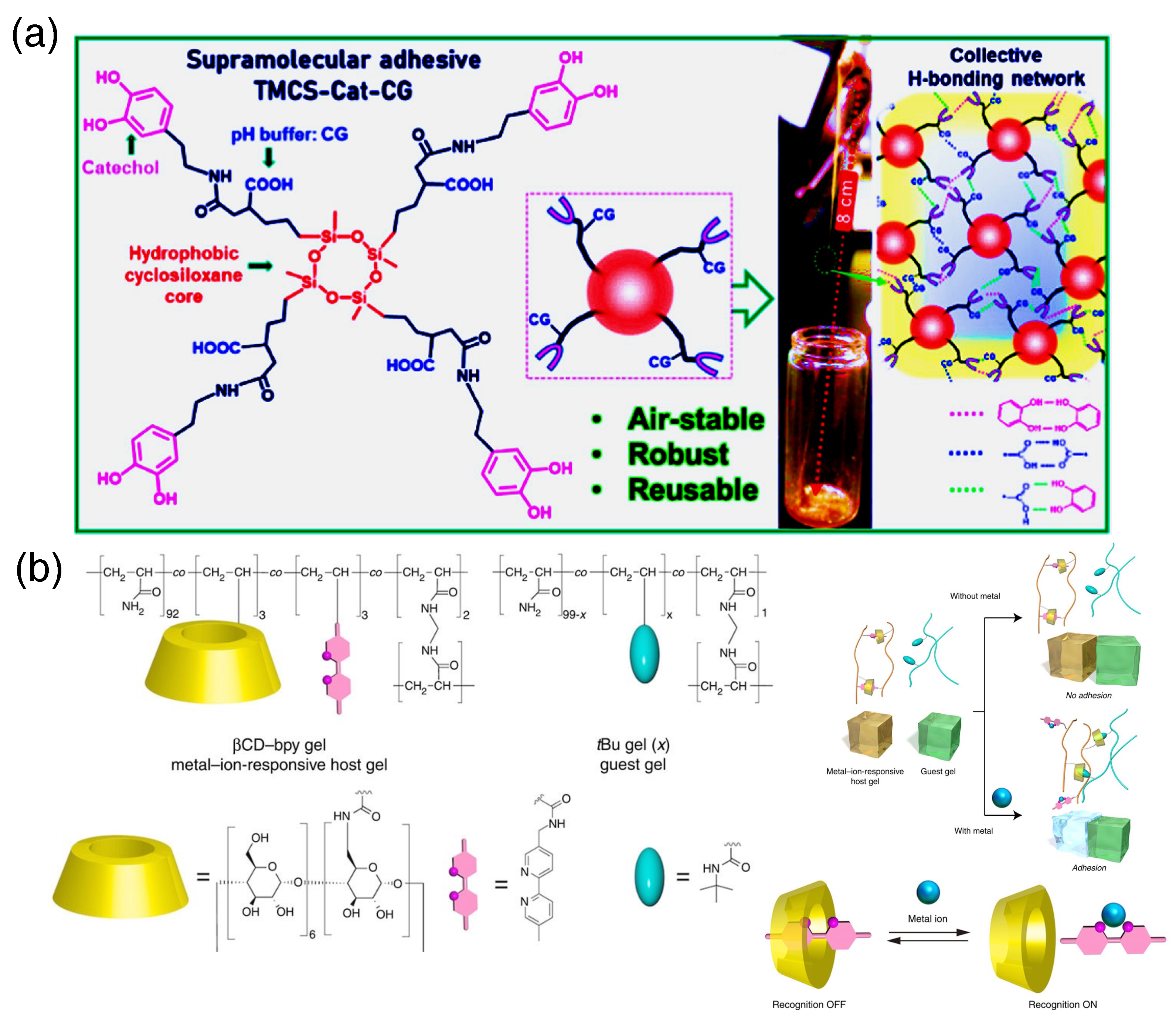
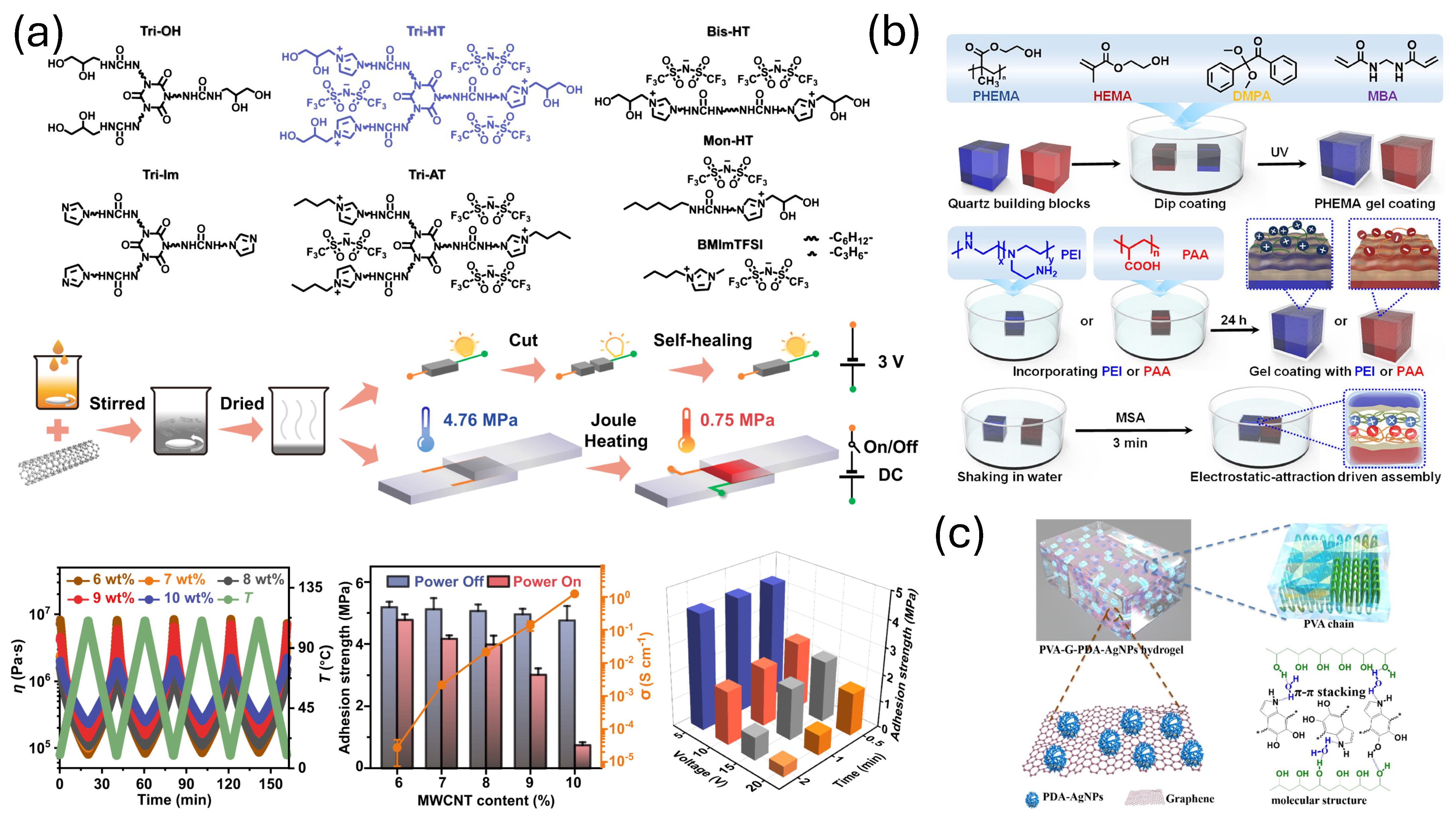
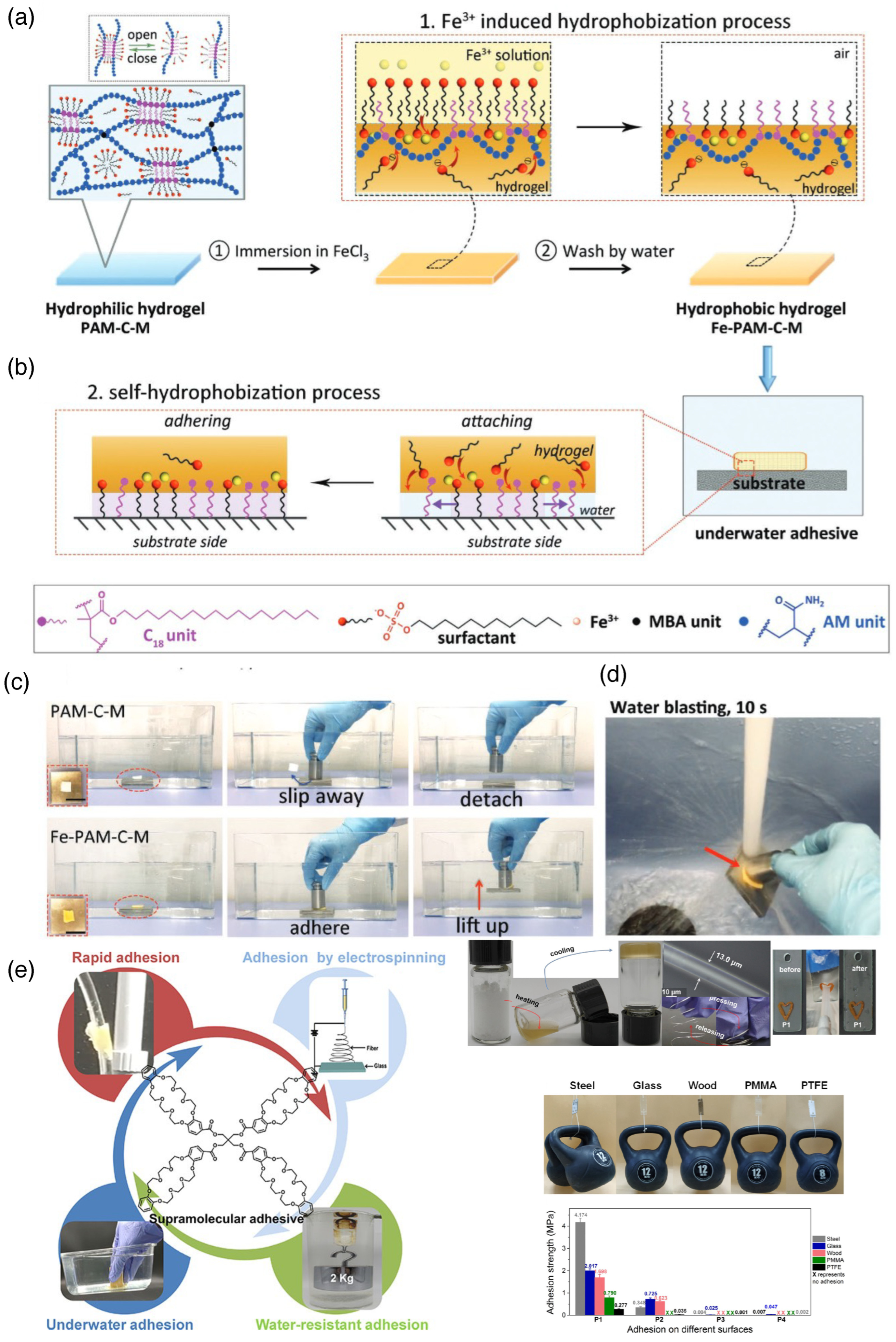
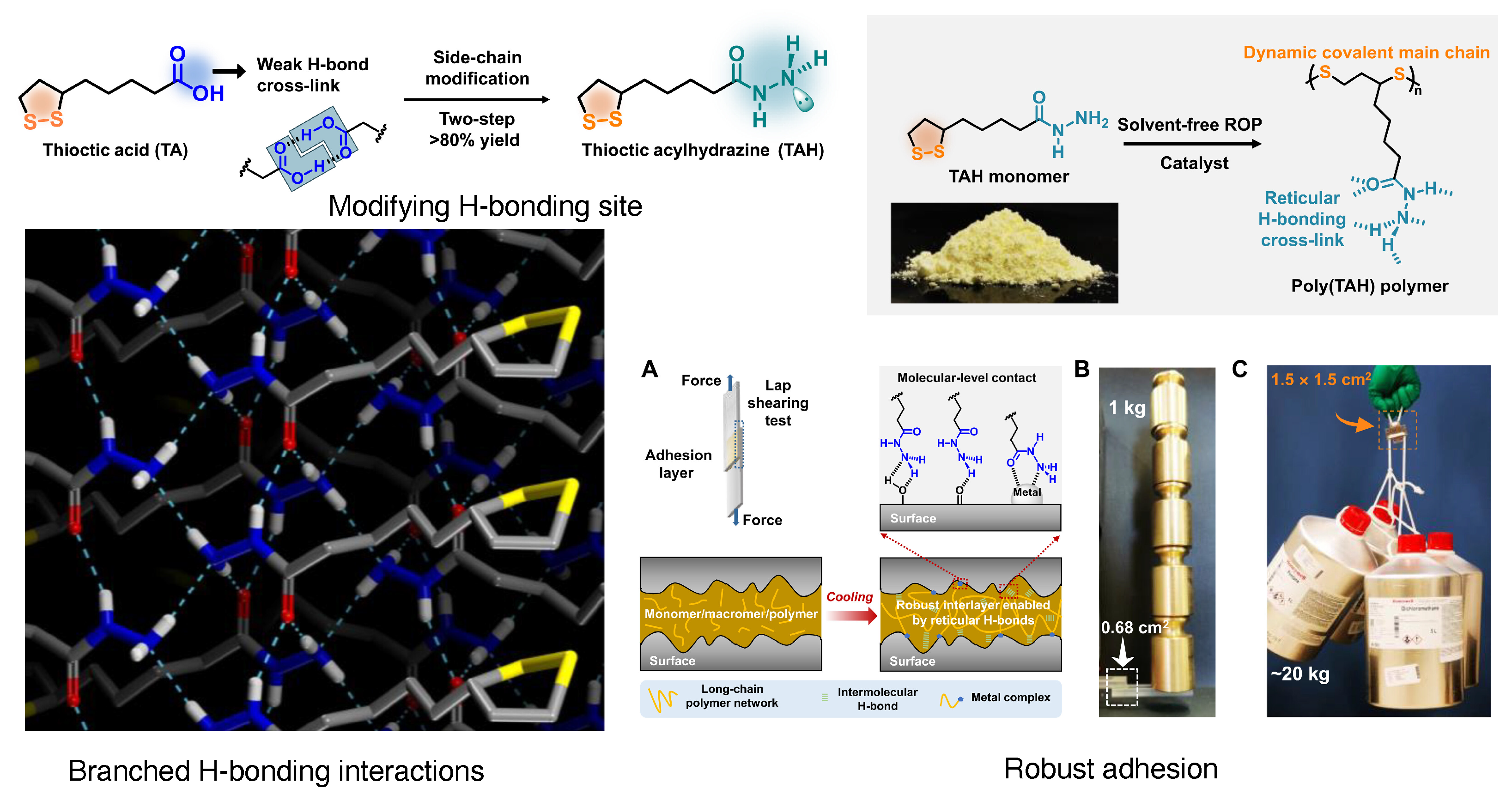
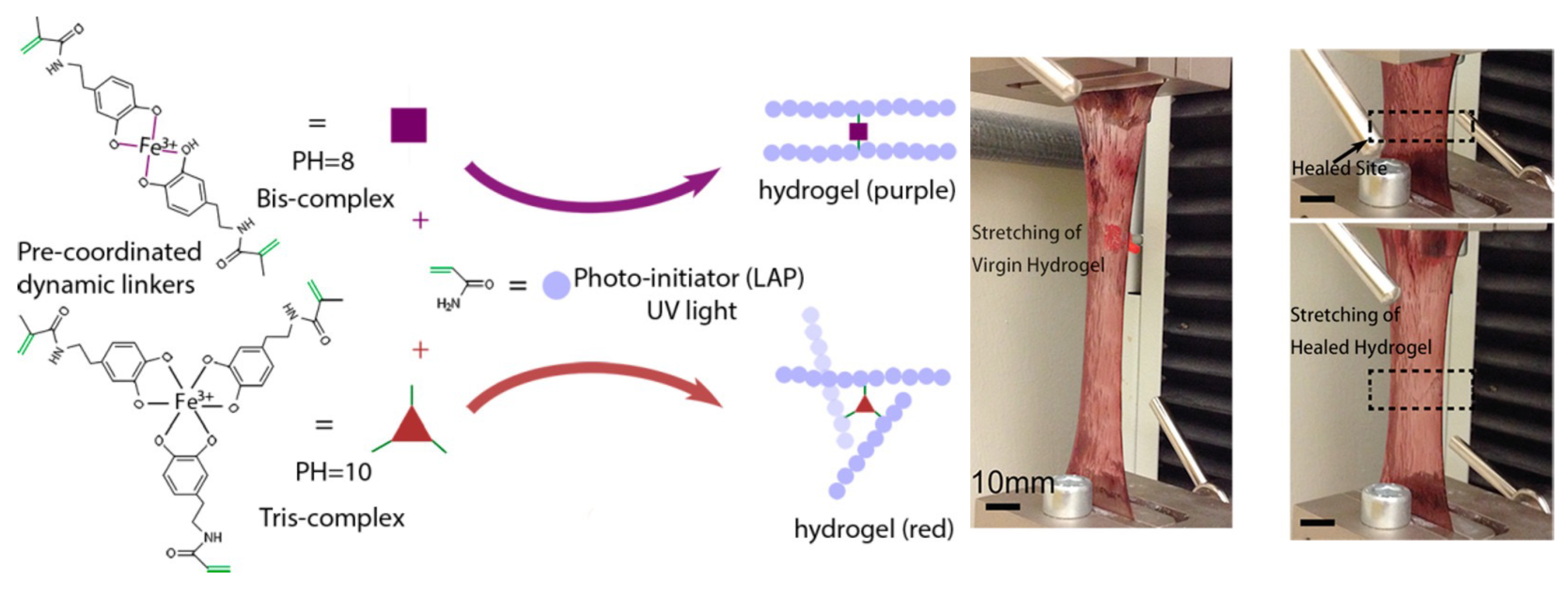
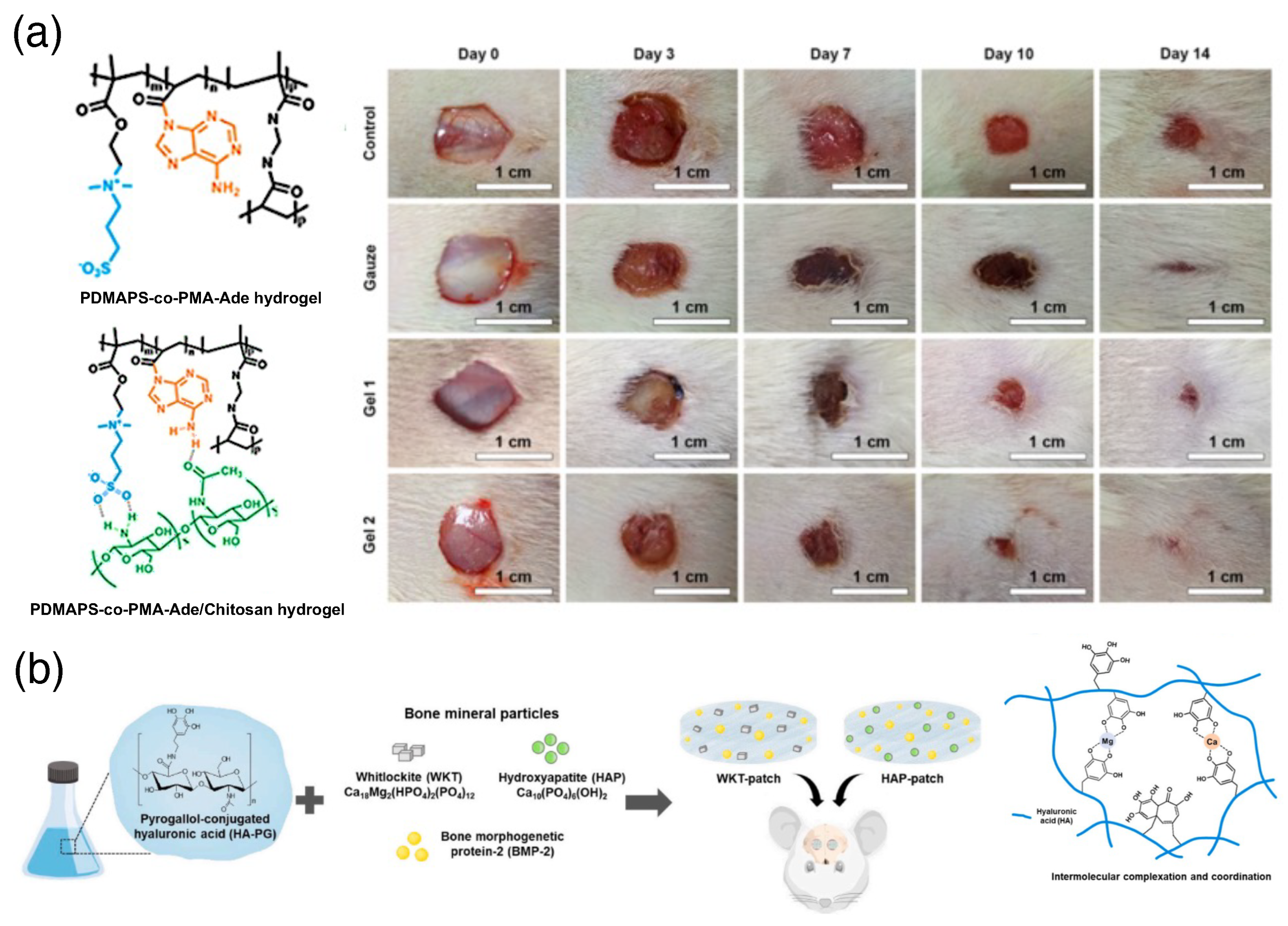
Disclaimer/Publisher’s Note: The statements, opinions and data contained in all publications are solely those of the individual author(s) and contributor(s) and not of MDPI and/or the editor(s). MDPI and/or the editor(s) disclaim responsibility for any injury to people or property resulting from any ideas, methods, instructions or products referred to in the content. |
© 2025 by the authors. Licensee MDPI, Basel, Switzerland. This article is an open access article distributed under the terms and conditions of the Creative Commons Attribution (CC BY) license (https://creativecommons.org/licenses/by/4.0/).
Share and Cite
Baral, A.; Basu, K. Supramolecular Adhesives Inspired by Nature: Concept and Applications. Biomimetics 2025, 10, 87. https://doi.org/10.3390/biomimetics10020087
Baral A, Basu K. Supramolecular Adhesives Inspired by Nature: Concept and Applications. Biomimetics. 2025; 10(2):87. https://doi.org/10.3390/biomimetics10020087
Chicago/Turabian StyleBaral, Abhishek, and Kingshuk Basu. 2025. "Supramolecular Adhesives Inspired by Nature: Concept and Applications" Biomimetics 10, no. 2: 87. https://doi.org/10.3390/biomimetics10020087
APA StyleBaral, A., & Basu, K. (2025). Supramolecular Adhesives Inspired by Nature: Concept and Applications. Biomimetics, 10(2), 87. https://doi.org/10.3390/biomimetics10020087






